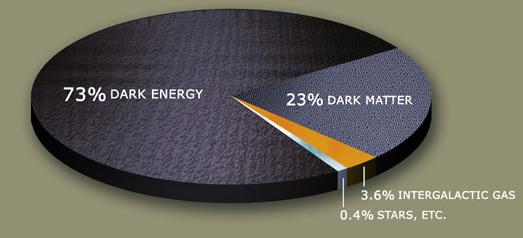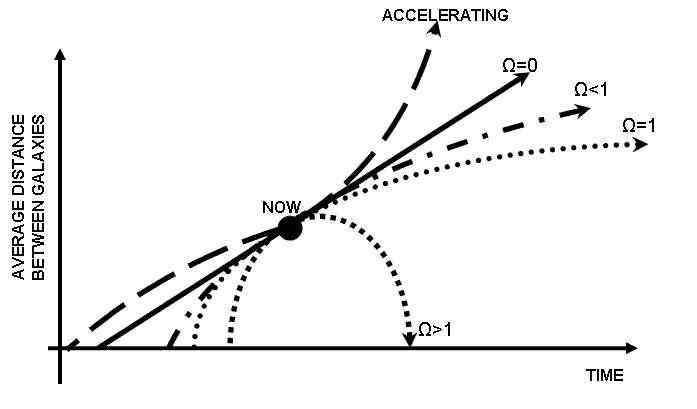Cosmology: How it will end.. The Big Freeze?
|
The Geometry of Space Recall from our discussion of relativity and black holes, space-time is warped in the presence of matter. There are three options for the geometry of space: positive (lots of matter), zero (the 'Goldilocks' scenario) or negative (too little matter) curvature. |

|
|
A Closed Universe has what is called
positive curvature, and looks like a sphere. In a closed universe, when you get to
very large scales, the circumference of a circle is smaller
than 2*pi*R and all the angles in a triangle add up to MORE than
180.
A Flat Universe has zero curvature, geometry works the way you learned in school. The angles of a triangle add up to 180, and the circumference of a circle equals 2*pi*R no matter how you curl or manipulate a sheet of paper. |

|
| An Open Universe has negatively curved space. It looks like a "saddle" or "potato chip". In such a universe, the circumference of a circle is GREATER than 2*pi*R and the angles in a right triangle add up to LESS than 180. See also: here |

|
Our accelerating Universe!
In the 1990's two teams of astronomers, the Supernova Cosmology Project and the High-Z Supernova Search, were looking for distant type Ia supernovae in order to measure the expansion rate of the universe with time. They expected that the expansion would be slowing, which would be indicated by the supernovae being brighter than their redshifts would indicate. Instead, they found the supernovae to be fainter than expected. Hence, the expansion of the universe was accelerating!
 Theory and observations tell us our universe is FLAT
Theory and observations tell us our universe is FLAT
This is based on various measures of the curvature of the universe. However, the observers had not been able to find enough matter to balance the energy of the expansion to create a flat universe. Only about 4% of the matter needed for a flat universe is known. Even when we include all the dark matter, as measured by gravitational effects, this only accounted for about another 23% of the energy needed for a flat universe. Because there is not enough matter in the universe - either ordinary or dark matter - to produce this flatness, the difference must be attributed to a "dark energy". This same dark energy causes the acceleration of the expansion of the universe. It acts just like gravity only it is repulsive to mass. In addition, the effect of dark energy seems to vary, with the expansion of the Universe slowing down and speeding up over different times.
 What is the FATE of our Universe then?
What is the FATE of our Universe then?
Omega, which represents the total mass/energy of the universe, appears to be just sufficient (Omega = 1) to keep the expansion going on for ever without the universe ever collapsing on itself (Omega > 1). Thus, the universe is presently predicted to go on for infinity, ever expanding until all matter is so far spread out that the universe will die a cold, long, drawn out death.